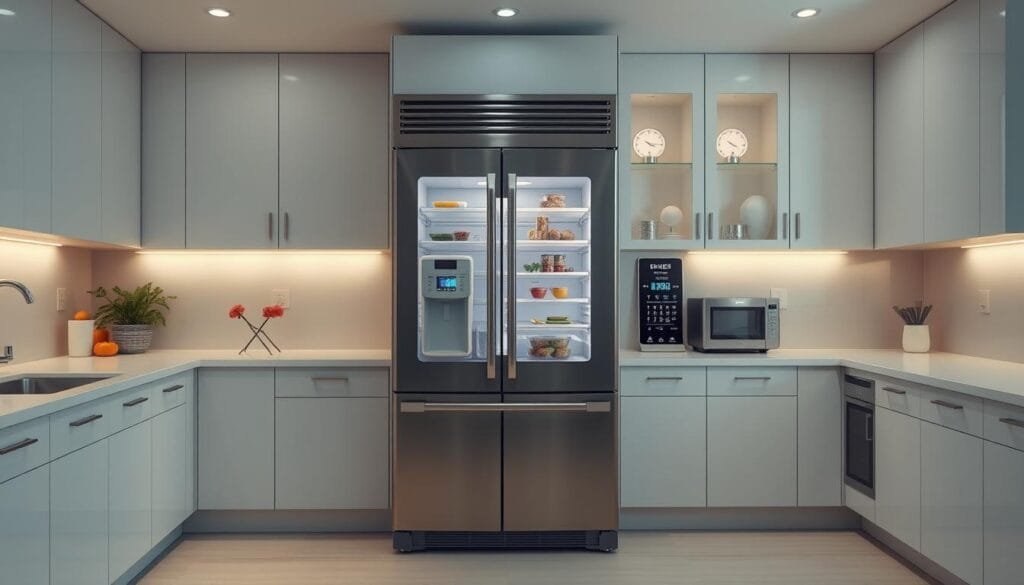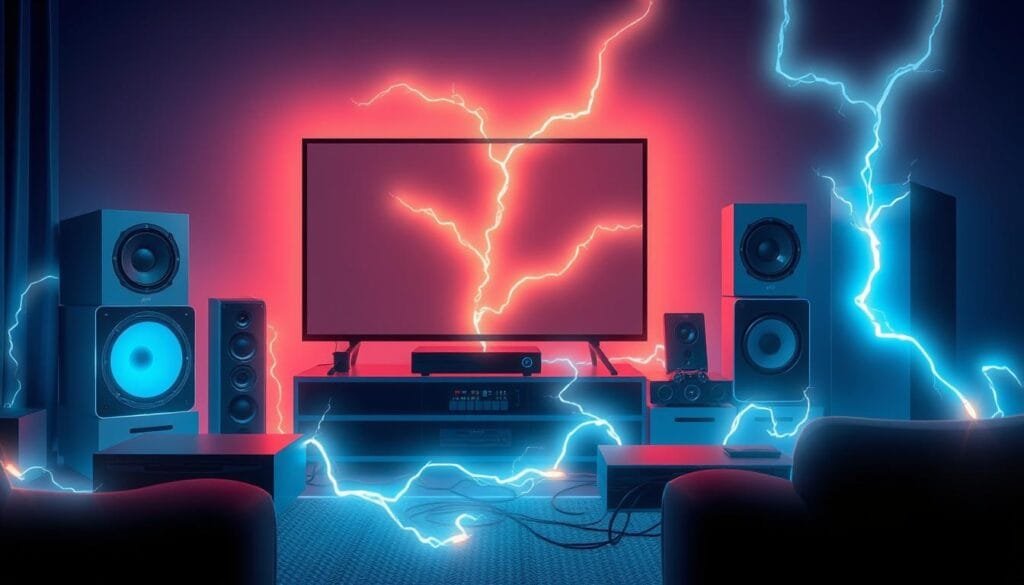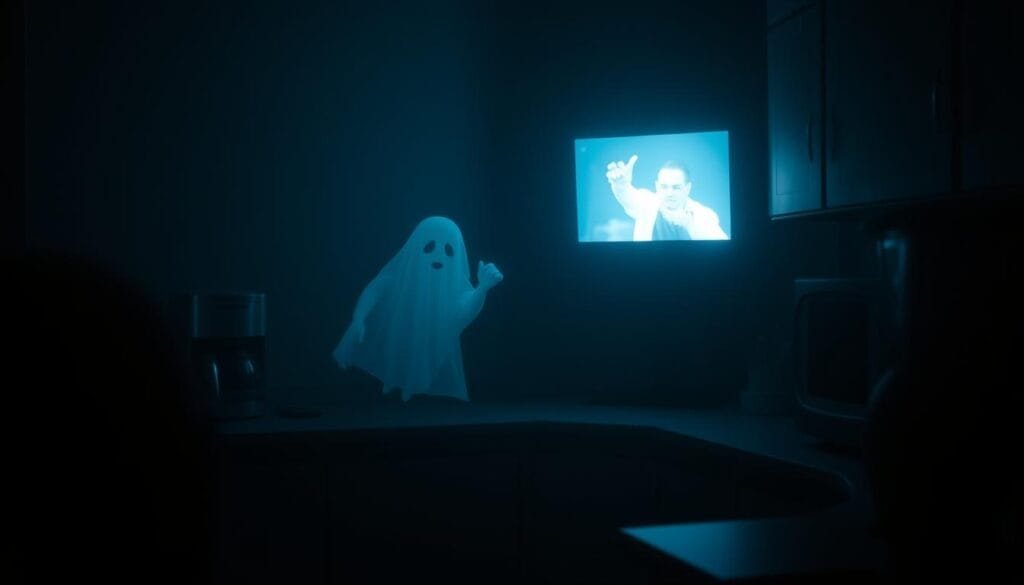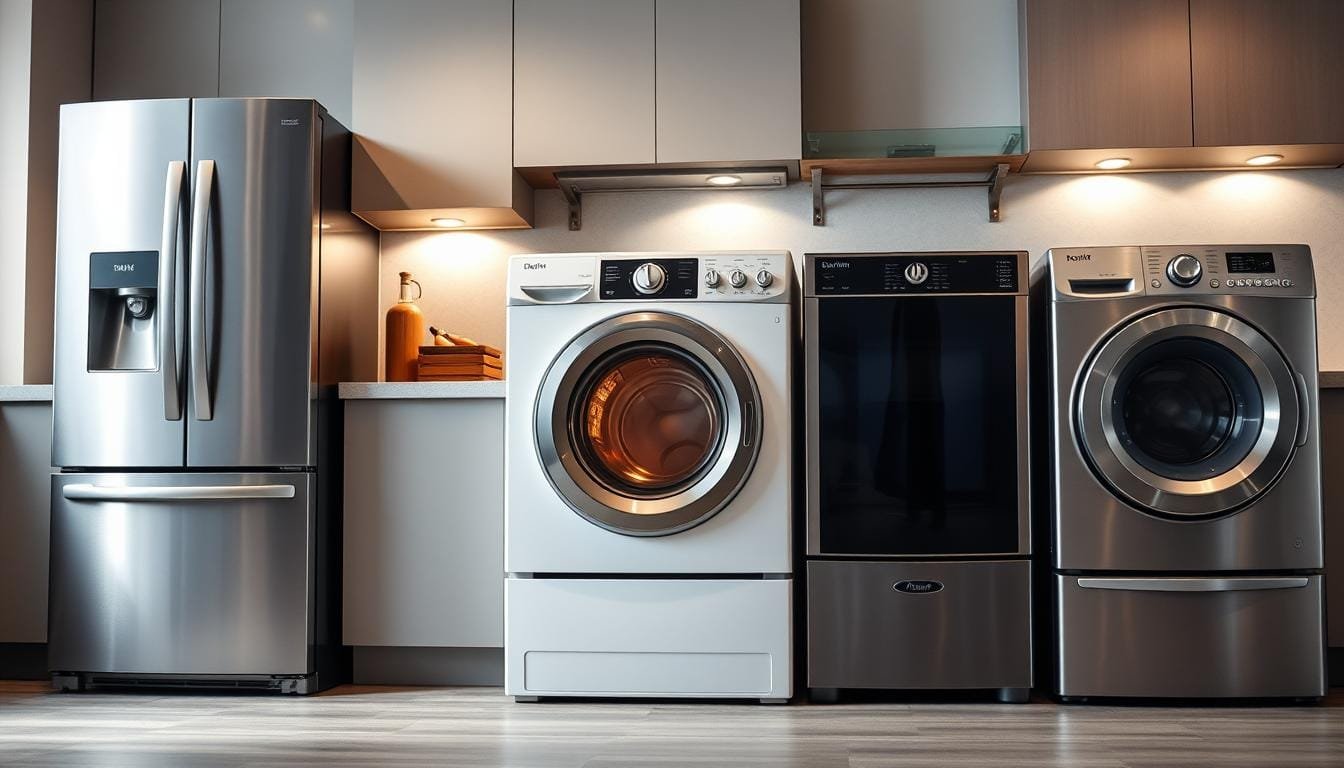In 2019, the average U.S. household spent $115 per month on electricity. Many homeowners don’t know which devices use the most power. Several surprising appliances quietly use a lot of energy.
Not all appliances use the same amount of electricity. For example, a refrigerator runs all the time and uses a lot of energy. Homes often use only 65% of their electricity, wasting 35% due to inefficient appliances.
Home energy use is complex. Different devices, from kitchen appliances to entertainment systems, affect your energy use. Each one adds to your total energy footprint.
Key Takeaways
- Average household electricity spending reaches $115 monthly
- Refrigerators are constant energy consumers
- 35% of electricity is potentially wasted through inefficient usage
- Continuous appliances significantly impact energy bills
- Understanding device energy consumption can lead to cost savings
Understanding Residential Energy Consumption Patterns
Electricity usage in American homes is complex. With an average cost of $0.11 per kilowatt-hour, it’s key to know where energy is used. This helps homeowners control their monthly bills.
A typical U.S. home uses about 10,500 kilowatt-hours of electricity each year. Usage varies by region:
- Northeast: ~7,000 kWh
- Midwest: ~10,000 kWh
- South: ~14,000 kWh
- West: ~8,000 kWh
Average Monthly Electricity Costs
Household spending on energy shows interesting patterns. Electric water heaters use about 14% of electricity. Air conditioners use around 17%.
Factors Affecting Energy Usage
Several things affect how much electricity a home uses:
- Home size and type
- Geographic location
- Number of occupants
- Appliance efficiency
Impact of Standby Power on Bills
“Phantom loads” from devices switched off can silently drain electricity, creating hidden costs for unsuspecting households.
Most homes waste about 35% of electricity. This is due to inefficient use and standby power. Using smart monitoring can cut down on these costs and improve energy efficiency.
Air Conditioning and Heating: The Biggest Energy Consumers
Your home’s HVAC system is the biggest electricity user, taking up to 50% of your energy. Air conditioners and space heaters are key players in this high energy use. They greatly affect your monthly electricity bills.
Heating and cooling systems have surprising energy facts. Central air conditioners use 2,000 to 5,000 watts per hour. Space heaters add to the load, mainly in winter.
“Efficient HVAC management can dramatically reduce household energy expenditure.” – U.S. Department of Energy
Key Energy Consumption Factors
- Central air conditioning units use 3,000-5,000 watts hourly
- Window air conditioner units consume 500-1,500 watts
- Heating systems represent approximately 29% of residential energy use
Seasons change energy use a lot. In summer, air conditioners work hard. In winter, space heaters are key. Using programmable thermostats can cut energy use by 10-30% a year.
| HVAC Component | Average Energy Consumption | Annual Cost Impact |
|---|---|---|
| Central Air Conditioning | 3,500 watts/hour | $300-$500 |
| Space Heater | 1,500 watts/hour | $100-$250 |
Using energy wisely can lower your bills. Good insulation, regular upkeep, and smart thermostat use are key. They help cut down on HVAC energy use.
Electric Water Heaters: Second Largest Energy Draw
Electric water heaters are big energy users in many American homes. They work hard to give us hot water every day. But, they use a lot of electricity.
Daily Usage Patterns
An electric water heater uses about 13.5 kWh each day. That’s around 405 kWh a month. This makes up almost 14% of what we spend on energy at home. Keeping the water hot all the time uses a lot of energy.
Energy-Saving Tips for Water Heating
- Lower the water heater temperature to 120°F
- Insulate water heater pipes
- Install low-flow showerheads
- Use cold water for laundry when possible
- Consider taking shorter showers
Modern Efficiency Solutions
There are smart ways to make your electric water heater work better:
| Solution | Potential Energy Savings |
|---|---|
| Tankless Water Heaters | 10-15% reduction in energy use |
| Solar Water Heating Systems | 50-80% reduction in water heating costs |
| Heat Pump Water Heaters | 60% more energy efficient |
“Upgrading your electric water heater can lead to significant long-term energy savings and reduced utility bills.” – Energy Efficiency Experts
Learning about electric water heater use and using smart tips can cut down energy costs. This way, we can save money and keep our water hot.
Refrigerators: Always-On Energy Usage

Refrigerators are the fifth biggest energy users in American homes. They run all the time, which adds a lot to our electricity bills. An average fridge uses about 162 kWh each month. This means a lot of energy is used every year.
About 1 in 4 Americans have a second fridge. This increases energy use. Having an extra fridge can cost around $125 a year on your electricity bill.
Energy efficiency starts with understanding your refrigerator’s impact on household electricity consumption.
Factors Affecting Refrigerator Energy Efficiency
- Age of the refrigerator
- Maintenance frequency
- Internal temperature settings
- Seal quality of door gaskets
- Location and surrounding temperature
Energy-Saving Tips for Refrigerators
- Keep refrigerator temperatures between 37-40°F
- Clean coils regularly
- Avoid placing the refrigerator near heat sources
- Check door seals for proper closure
- Consider upgrading to an Energy Star model
| Refrigerator Type | Average Annual Energy Consumption | Estimated Annual Cost |
|---|---|---|
| Standard Top Freezer | 430-500 kWh | $50-$60 |
| Side-by-Side Model | 590-700 kWh | $70-$85 |
| Energy Star Certified | 350-450 kWh | $40-$55 |
Buying an energy-efficient fridge can save you money over time. New models use less energy but keep your food cold. They have better insulation and technology.
Name an Appliance That Uses a Lot of Electricity: Breaking Down Power-Hungry Devices
The clothes dryer is a big energy user in many American homes. Knowing which appliances use a lot of power helps homeowners save money and energy.
Electricity use varies a lot among household appliances. Some appliances use a lot of power, even when not in use. This is called “vampire” energy drain.
Common High-Consumption Appliances
- Clothes dryer: Uses approximately 3-5 kW per cycle
- Electric water heater: Consumes around 4-5 kW continuously
- Central heating systems: Account for over 40% of home electricity usage
- Air conditioning units: Major electricity consumers during summer months
Understanding Wattage Ratings
Wattage shows how much electricity an appliance uses. Higher wattage means more energy used. For example, a clothes dryer can use between 1,800 to 5,000 watts, which can cost a lot over time.
Peak Usage Times
“Unplugging appliances can save $100-$200 annually,” according to the US Department of Energy.
Using appliances wisely can cut down on electricity costs. Running big users like clothes dryers when rates are lower can help save money.
By knowing how appliances use power, people can make better choices. This can lead to big savings on electricity bills.
Laundry Equipment: Washers and Dryers
Laundry equipment is a big part of household energy use. Clothes dryers and washing machines use about 5% of a home’s energy. They draw an average of 3,045 watts combined.
Choosing energy-efficient laundry appliances is key. ENERGY STAR certified front load washers have big advantages:
- They use 45% less energy.
- They use 50% less water than top load agitator washers.
- They are 25% more efficient than top load impeller models.
Today’s clothes dryers are much more energy-efficient. There are many options that use less electricity:
- Heat pump clothes dryers
- Ventless electric models
- Gas-powered efficient units
“Choosing an energy-efficient clothes dryer can greatly cut down on utility bills.”
Smart shoppers should look at the Integrated Modified Energy Factor (IMEF) when buying washing machines. This measure shows how well a washer uses energy. It helps homeowners make smart choices for their laundry needs.
By picking energy-efficient washers and dryers, homes can save money and help the environment.
Kitchen Appliances: Electric Ovens and Cooktops
Modern kitchens depend on electric ovens and cooktops for easy cooking. These appliances offer many cooking options and use a lot of energy at home.
Energy Usage During Cooking
Electric ovens use about 2,500 watts per hour. Cooktops use around 1,500 watts on medium-high heat. This can lead to high monthly electricity bills.
- Standard electric ovens use 120-volt or 240-volt circuits
- Average cooking time impacts overall energy consumption
- Preheating contributes significantly to energy use
Smart Cooking Practices
To cut down on energy use with an electric oven, try these tips:
- Batch cook multiple dishes at once
- Use ceramic or glass cookware for better heat distribution
- Don’t open the oven door too often during cooking
Efficiency Alternatives
There are energy-saving options to traditional electric ovens:
- Convection ovens cook evenly with less energy
- Induction cooktops heat food precisely and efficiently
- Air fryer ovens cook healthier and use less energy
Smart ovens now let you control them with your smartphone. This shows the future of energy-saving cooking tech.
The Hidden Cost of Entertainment Systems
Entertainment systems use a lot of energy in today’s homes. About 4% of household energy goes to electronics. This includes TVs, gaming consoles, and streaming devices.

Modern entertainment setups have many devices that use power all the time. Phantom power can add up to 10% to your home’s energy costs. Many devices use electricity even when they’re not on.
“75% of the electricity consumed by plugged-in devices is used when they are not actively in use.” – Energy Consumption Research
Energy Consumption Breakdown
| Device | Typical Monthly Energy Cost | Standby Power Consumption |
|---|---|---|
| Gaming Console | Varies by model | High |
| Smart TV | $5-$10 | Moderate |
| Cable/Satellite Box | $3-$7 | High |
Energy-Saving Strategies
- Use smart power strips to eliminate standby power
- Choose ENERGY STAR® certified devices
- Unplug devices when not in use
- Adjust device power settings to minimize consumption
Using these strategies can help lower the hidden energy costs of entertainment systems. Being mindful of how you use electronic devices can save you money on your electricity bills.
Lighting Systems: Impact on Energy Bills
Lighting is a big user of electricity in homes today. On average, 15% of a household’s electricity goes to lighting. This makes it a key area for saving energy.
LED technology has changed how we light our homes and use electricity. These bulbs are a game-changer because they:
- Use up to 90% less energy than old bulbs
- Last 25 times longer than regular bulbs
- Can save homeowners about $225 a year
Smart lighting strategies can really cut down on electricity bills. Homeowners have many ways to use less energy, like:
- Putting in motion-sensor switches
- Using dimmer controls
- Getting automatic daylight shut-off systems
“Energy-efficient lighting isn’t just about saving money—it’s about creating a sustainable home environment.” – Energy Conservation Expert
When picking out lighting, think about using LEDs instead of old bulbs. LEDs for 40W to 100W equivalents are a smart choice. They use much less electricity.
Using smart switches can also help save energy. It can cut home energy use by 35-45%. By choosing the right lighting, homeowners can make their homes more energy-efficient and save money in the long run.
Vampire Appliances: Understanding Standby Power Consumption
Vampire appliances quietly use electricity even when they seem off. They create an invisible energy burden for homes. These sneaky power users can greatly increase your electricity bills without you noticing.

The National Renewable Energy Laboratory says vampire appliances can cost up to $200 per year for an average home. This hidden energy use is a big financial and environmental problem.
Common Culprits of Standby Power Consumption
- Smart TVs with continuous displays
- Gaming consoles
- Computer chargers
- Kitchen appliances with LED displays
- Entertainment systems
“Up to 10% of residential energy use comes from standby power consumption” – U.S. Department of Energy
Prevention Methods
To cut down on vampire power, we need smart ways to use electricity. The best way to reduce standby power is to use smart power strips and unplug devices when not in use.
| Prevention Strategy | Potential Annual Savings |
|---|---|
| Smart Power Strips | $10-$30 |
| Unplugging Devices | $50-$100 |
| Energy Star Products | 15-30% Reduction |
By using these methods, homes can cut down on energy waste and lower bills. Knowing about vampire appliances and managing them is a simple yet effective way to save energy.
Smart Technology Solutions for Energy Management
Modern smart technology offers new ways to manage home energy. Homeowners can now use smart devices to control and lower energy use from big electricity users.
Smart home solutions give us more control over energy use. These advanced technologies track and improve energy use with cool features.
- Smart thermostats that learn user habits
- Remote-controlled smart plug devices
- Energy monitoring systems
- Automated appliance control mechanisms
“Smart technology transforms how we understand and manage home energy consumption” – Energy Innovation Expert
Smart thermostats can cut energy use by letting us make changes in real time. They learn our habits and can save a lot on bills.
| Smart Device | Energy Saving Potencial | Key Feature |
|---|---|---|
| Smart Thermostat | Up to 15% HVAC savings | Learns user temperature preferences |
| Smart Plug | 10-25% device energy reduction | Remote power management |
| Energy Monitoring System | 20-30% overall consumption reduction | Real-time usage tracking |
Using smart home tech lets us control energy use better. By tracking and managing energy, we can live more efficiently and save money.
The future of home energy management is in smart, connected tech. It lets us make smart choices about our energy use.
Energy Star Ratings and Efficiency Standards
Homeowners are now more focused on cutting down their electricity bills. The Energy Star program, started by the U.S. Environmental Protection Agency in 1992, helps them find energy-saving appliances.
Energy Star has saved an amazing five trillion kilowatt hours of electricity. This equals about $500 billion in energy savings. It shows how big of an impact the program has had on energy use.
Understanding Energy Labels
Energy Star labels give important details about an appliance’s energy use. They help consumers spot appliances that use a lot of electricity.
- Labels show how much energy efficient an appliance is compared to standard ones
- Color-coded ratings make it simple to compare
- They also show the estimated yearly energy cost
Cost-Benefit Analysis
Buying Energy Star certified appliances has big long-term benefits:
| Appliance Type | Annual Energy Savings | Lifetime Cost Reduction |
|---|---|---|
| Freezer | 215 kWh | $410 |
| Dryer | 20% less energy | Varies by model |
“Energy efficiency is not just about saving money, but also about reducing environmental impact.” – EPA Energy Star Program
Federal tax credits of up to $3,200 per year for energy-efficient upgrades make Energy Star products even more attractive. The program now covers 75 product categories. This means consumers can find efficient options for many different appliances.
Time-of-Use Rate Strategies
Understanding time-of-use (TOU) rate strategies can help lower your electricity bills. Electricity prices change throughout the day. This gives smart consumers a chance to save money.
Peak hours are when most people use electricity. They usually happen in the afternoon and early evening. In most places, this is between 3-7 p.m. on weekdays. Rates are highest then because more people are using power.
“Smart energy management can reduce monthly electricity bills by 10-30%.”
Optimal Strategies for Reducing Electricity Costs
- Shift energy-intensive tasks to off-peak hours
- Use appliances like dishwashers and washing machines during low-rate periods
- Program smart appliances to run during cheaper rate windows
- Preheat or precool your home before peak hours
Here are some peak hour times for different areas:
- Eastern Region: 2-6 p.m. summer, 6-10 a.m. and 6-10 p.m. winter
- Central Region: 1-5 p.m. summer, 5-9 a.m. and 5-9 p.m. winter
- Mountain Region: 8 a.m.-11 p.m. summer, 7 a.m.-10 p.m. winter
- Pacific Region: 5-9 p.m. summer, 6-10 a.m. and 5-8 p.m. winter
Weekends usually have lower rates all day. By planning when to use big electricity users like air conditioners and ovens, you can cut down your bill a lot.
Conclusion
Knowing which appliances use a lot of electricity is key to saving on household bills. Homes have many ways to cut down on energy use. For example, air conditioners and water heaters, as well as everyday items like dishwashers and dehumidifiers, all play a role.
The average U.S. home spends $1,368 a year on electricity. Appliances like HVAC systems use up to 47% of all energy. This shows how important it is to know which appliances use the most.
Spotting appliances that use a lot of electricity helps homeowners make better choices. Space heaters, water heaters, and air conditioners use 57.1% of home energy. Upgrading to Energy Star appliances and using smart technology can save a lot.
Using smart strategies like these can lead to big savings. It’s also important to be mindful of standby power.
The best way to cut down on electricity costs is to install home solar panels. They make clean, renewable energy. This way, homeowners can save money and help the environment.
Using energy-saving practices on various appliances also helps. This includes using less on dishwashers and dehumidifiers. It also means managing heating and cooling systems better.
Energy efficiency is about being aware and making smart choices. By understanding your home’s energy use and making informed decisions, you can make your home more sustainable and save money.

